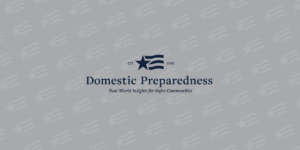

Answering the ‘What Ifs’ with Real-Life Training
Richard Schoeberl
August 24, 2011
The still young 21st century has already seen more acts of major terrorism, and more natural
disasters, than ever before in recorded history. Most nations are for that reason improving their
preparedness and response capabilities. But that is not enough – those capabilities must be thoroughly
tested through a probably unending series of drills, exercises, and both individual and team training
programs.

Studying Hazardous Material Protective Gear in Action
Terrence K. Cloonan
August 17, 2011
With training programs offered in a “true toxic environment,” the Center for Domestic Preparedness (CDP) offers the perfect environment to test and develop new requirements, guidelines, and procedures for personal protective equipment (PPE). Building user confidence in PPE is yet another opportunity offered to emergency responders at the CDP.

Corporate Support for a Healthcare Facility in Crisis
Craig DeAtley
August 17, 2011
Hospitals and other healthcare facilities are marvelous at handling emergencies, healing the sick, and performing a host of minor and major daily miracles. But who heals the healer? In other words, what happens when the hospital itself is suffering from an explosion, an out-of-control fire, or any other type of mass-casualty incident? Today, the answer starts outside the facility with an emergency management program led and monitored by a corporate incident management team.

UK Approaches in Disaster Medical Education
James M. Matheson and Robert Stellman
August 17, 2011
In the long history of disaster medicine, it has never been more apparent than now how important it is to collaborate with a wide variety of disciplines and jurisdictions, both nationally and abroad. Responders from around the world can learn a lot from the UK’s expanding disaster medicine education and training programs.

Training for Multi-Agency Response Efforts
Jennifer Smither
August 10, 2011
Even successful responses can highlight areas in which improvement is needed in the training of responders, which is one reason – a big one – why the sharing of lessons learned is so important. Enhanced training that includes lessons from real-world situations and events can help responders familiarize themselves with their own roles, the policies of their agencies, and the unique challenges of working with other agencies during a multi-agency extended response.

Training, Exercises, and the ICS: A Natural Fit
Stephen Grainer
August 10, 2011
The NFL’s energetic but belated start on pre-season training is a timely reminder that even the best-conditioned and most highly skilled players cannot rest on last year’s laurels. The same is true, but much more so, of emergency responders, whose goal is not to win the Super Bowl but to save human lives – sometimes including their own.

The New CDC ‘Zombies’ of Emergency Preparedness
Joseph Cahill
August 3, 2011
The immense increase in the use of social media offers many new opportunities to educate the American people on emergency preparedness in general and to move agency messages to a broader target audience. Another result of the much expanded range of information outlets – primarily the Internet – is that the media itself often plays a backseat role while their message is being widely disseminated.

All-Hazards Response Training Updated & Expanded
Shannon Arledge
August 3, 2011
The massive increase in workload at FEMA’s Center for Domestic Preparedness has led to not only a
parallel increase in the center’s own specialized capabilities but also a Noble upgrading of facilities,
equipment, and the training curriculum. The other good news, for state and local budget managers, is
that all expenses are federally funded.

FINAL REPORT: The Future of Grants in Domestic Preparedness
Marko Bourne
August 2, 2011
Experts agree that the reduction in federal grant funds will have a significant impact on state and
local jurisdictions. The solution: Recognize past successes and failures, understand current concerns,
and develop regional approaches for the future. This report provides valuable information for
responders, receivers, planners, and managers who apply for or benefit from federal grants.

